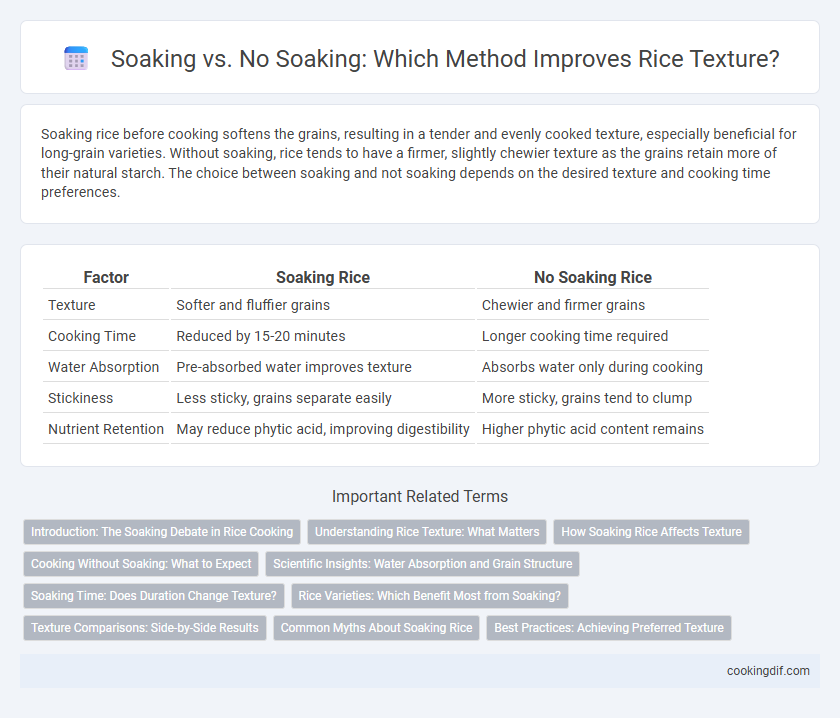Soaking rice before cooking softens the grains, resulting in a tender and evenly cooked texture, especially beneficial for long-grain varieties. Without soaking, rice tends to have a firmer, slightly chewier texture as the grains retain more of their natural starch. The choice between soaking and not soaking depends on the desired texture and cooking time preferences.
Table of Comparison
| Factor | Soaking Rice | No Soaking Rice |
|---|---|---|
| Texture | Softer and fluffier grains | Chewier and firmer grains |
| Cooking Time | Reduced by 15-20 minutes | Longer cooking time required |
| Water Absorption | Pre-absorbed water improves texture | Absorbs water only during cooking |
| Stickiness | Less sticky, grains separate easily | More sticky, grains tend to clump |
| Nutrient Retention | May reduce phytic acid, improving digestibility | Higher phytic acid content remains |
Introduction: The Soaking Debate in Rice Cooking
Soaking rice affects its texture by altering the starch and moisture absorption, leading to softer and more evenly cooked grains. Unsoaked rice retains a firmer texture and requires longer cooking time, impacting the final dish's consistency. Understanding the soaking process is essential for achieving desired rice textures in diverse culinary applications.
Understanding Rice Texture: What Matters
Soaking rice hydrates the grains, reducing cooking time and resulting in a softer, more tender texture ideal for dishes like risotto or sushi. In contrast, cooking rice without soaking retains a firmer, chewier bite favored in pilafs and fried rice. Understanding the effects of soaking on starch gelatinization and water absorption is essential for achieving the desired rice texture.
How Soaking Rice Affects Texture
Soaking rice hydrates the grains, leading to a softer and more evenly cooked texture by reducing cooking time and preventing the outer layer from hardening. Without soaking, rice often cooks unevenly, with a firmer exterior and potentially gummy interior due to inconsistent water absorption. Soaking is particularly beneficial for varieties like basmati and jasmine, where texture and fluffiness are key to the dish's quality.
Cooking Without Soaking: What to Expect
Cooking rice without soaking results in a firmer, slightly chewier texture as the grains absorb water more slowly during cooking. This method requires longer cooking times and careful water-to-rice ratios to ensure even hydration and avoid undercooked centers. Expect a nuttier flavor and more defined grain separation when skipping the soaking step.
Scientific Insights: Water Absorption and Grain Structure
Soaking rice enhances water absorption, allowing grains to swell and soften uniformly, which results in a tender texture upon cooking. Without soaking, rice grains absorb water slower during cooking, maintaining a firmer and chewier structure as the starch granules gelatinize unevenly. Scientific studies indicate that soaking breaks down some surface starches, promoting better hydration and consistent cooking, while unsoaked grains retain a more rigid cellular structure affecting final texture.
Soaking Time: Does Duration Change Texture?
Soaking rice for 30 minutes to 2 hours allows grains to absorb water, resulting in a softer and fluffier texture after cooking. Longer soaking times break down starch molecules, reducing cooking time and preventing clumping or stickiness. In contrast, no soaking often leads to firmer, chewier rice with more uneven cooking and a higher risk of burning or sticking to the pot.
Rice Varieties: Which Benefit Most from Soaking?
Soaking rice grains prior to cooking significantly enhances the texture of long-grain varieties like Basmati and Jasmine, promoting uniform expansion and fluffiness. Medium and short-grain rice types, such as Arborio used in risottos, benefit less from soaking as their higher starch content naturally creates a creamier consistency. For aged or parboiled rice, soaking reduces cooking time and helps achieve a tender yet firm texture, while freshly harvested rice varieties typically require no soaking due to their inherent moisture levels.
Texture Comparisons: Side-by-Side Results
Soaking rice before cooking evenly hydrates grains, resulting in a tender, fluffy texture with distinct separation, whereas cooking without soaking often leads to firmer, slightly chewier grains due to uneven moisture absorption. Side-by-side texture comparisons reveal soaked rice produces a softer mouthfeel and less clumping, while unsoaked rice may retain a firmer bite and occasional grain stickiness. These differences affect cooking times as soaked rice cooks faster and absorbs water more uniformly, optimizing texture consistency in dishes.
Common Myths About Soaking Rice
Soaking rice is often believed to reduce cooking time and improve texture, but many common myths overstate its benefits; modern rice varieties cook evenly without soaking due to advanced milling techniques. Soaking primarily affects surface starch removal, which can slightly reduce stickiness in some types like basmati or jasmine, but it does not significantly alter the grain's internal texture. For most everyday cooking, rinsing rice thoroughly before cooking is sufficient to achieve a fluffy, non-sticky result without the need for soaking.
Best Practices: Achieving Preferred Texture
Soaking rice before cooking hydrates the grains, resulting in a softer, fluffier texture preferred for dishes like biryani or pilaf. Skipping soaking maintains a firmer, chewier texture ideal for fried rice or risotto where distinct grains are desired. Optimal cooking times and water ratios vary based on soaking, with soaked rice generally requiring less cooking time to achieve the best texture.
Soaking vs No Soaking for texture Infographic

 cookingdif.com
cookingdif.com